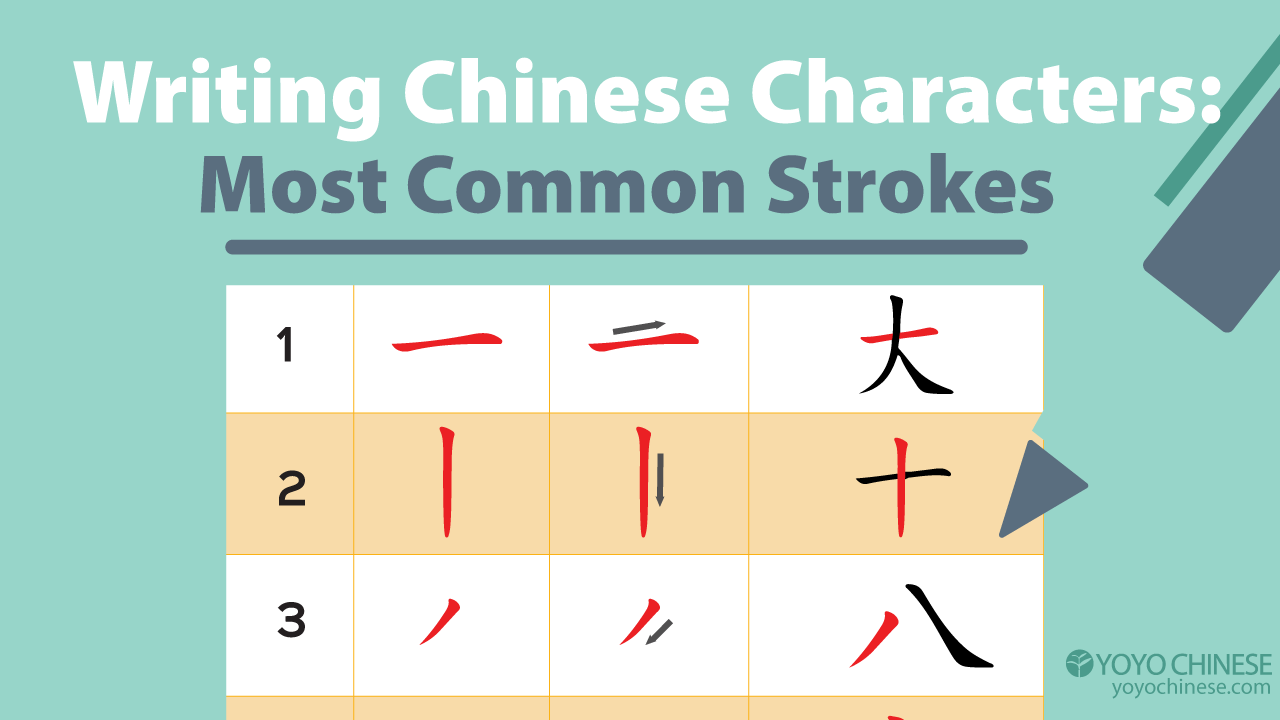Chinese Characters: Most Common Strokes

Intro to Chinese Characters Strokes
If you’ve started to learn how to write Chinese characters, you’ve likely tried to replicate numerous different strokes in Chinese, according to a certain stroke order.
There are simple strokes, like the horizontal stroke, as found in 一 (yī)
There are also more complex ones that you’ll find, like the “vertical/turn” stroke in the left part of the character 山 (shān)![]() , or “mountain”, the “curve/hook” found at the bottom of 了 (le)
, or “mountain”, the “curve/hook” found at the bottom of 了 (le)![]() , an important particle in Chinese, and the “vertical/curve/hook” found at the bottom of 也 (yě)
, an important particle in Chinese, and the “vertical/curve/hook” found at the bottom of 也 (yě)![]() , meaning “also”, to name a few.
, meaning “also”, to name a few.

While we do not recommend you to sit down and memorize all of the Chinese character strokes, it’s good to have a list of the most common Chinese strokes that you’ll come across in your study of Chinese to reference. With that in mind, we’ve created a handy infographic with the 30 most common Chinese character strokes to know.
The list moves from the most simple, basic strokes, to the more difficult ones. A good rule of thumb is to try to learn the first 10 or so strokes, and then just keep adding new ones to your belt as you learn new characters.
If you’re taking our Chinese Character Course I or Chinese Character Course II, you’ll recognize a LOT of these strokes as well!
Infographic for the 30 Most Common Strokes
Be sure to download this infographic to your device for quick reference! Just right click to save it to your device, and then print it out!

If you’d like to look up the characters in the above image, check out the list below, complete with pinyin, English, audio samples and links to related lessons in our courses that include the featured stroke:
-
大 (dà)
 - big
- big
-
十 (shí)
 - ten
- ten
-
入 (rù)
 - to enter
- to enter
-
主 (zhǔ)
 - main/master
- main/master
-
口 (kǒu)
 - mouth/opening
- mouth/opening
-
人 (rén)
 - person/people
- person/people
-
地 (dì)
 - earth/ground
- earth/ground
-
月 (yuè)
 - month/moon
- month/moon
-
小 (xiǎo)
 - small/little/young
- small/little/young
-
水 (shuǐ)
 - water
- water
-
你 (nǐ)
 - you
- you
-
也 (yě)
 - also/too
- also/too
-
去 (qù)
 - to go/past
- to go/past
-
旅 (lǚ)
 - to travel
- to travel
-
山 (shān)
 - mountain
- mountain
-
女 (nǚ)
 - woman
- woman
-
弟 (dì)
 - younger brother
- younger brother
-
我 (wǒ)
 - I/me
- I/me
-
那 (nà)
 - that
- that
-
讲 (jiǎng)
 - to speak / 说 (shuō)
- to speak / 说 (shuō) - to say/speak/talk
- to say/speak/talk
-
了 (le)
 - (a common sentence particle)
- (a common sentence particle)
-
九 (jiǔ)
 - nine
- nine
-
四 (sì)
 - four
- four
-
没 (méi)
 - (have/did) not
- (have/did) not
-
仍 (réng)
 - even / 奶 (nǎi)
- even / 奶 (nǎi) - grandmother/milk
- grandmother/milk
-
风 (fēng)
 - wind
- wind
-
及 (jí)
 - (used in compound words with different meanings)
- (used in compound words with different meanings)
-
专 (zhuān)
 - specialty
- specialty
-
鼎 (dǐng)
 - three-legged cauldron
- three-legged cauldron
-
凹 (āo)
 - concave
- concave
Hungry for more?
Now that you know the most common strokes in Chinese, what is the order of each stroke in a given character?
Check out this blog post for the general rules about Chinese character stroke order.
We also cover the stroke order for the 300 most common Chinese characters in our Chinese Character Course I. You’ll learn how to read and write each Chinese character, stroke by stroke, as well as the meaning behind the characters, and how characters can combine together to form different words in Chinese!
Check out this sample lesson here:
Ready to start learning characters?
If you’re ready to make the jump into learning how to read and write Chinese characters, stroke by stroke, try out the first 2 units of our Chinese Character Course I for FREE here.
 ASHLEY LABRIE | JANUARY 29, 2020
ASHLEY LABRIE | JANUARY 29, 2020

 Chinese Is Easier Than You Think
Chinese Is Easier Than You Think What Is Pinyin?
What Is Pinyin? An Introduction to the Tones
An Introduction to the Tones The 1st and 2nd Tones
The 1st and 2nd Tones Numbers 0-10
Numbers 0-10 Learn Chinese Pronunciation RIGHT with the (FREE!) Yoyo Chinese Interactive Video & Audio Pinyin Chart
Learn Chinese Pronunciation RIGHT with the (FREE!) Yoyo Chinese Interactive Video & Audio Pinyin Chart [LIVE] How to Read a Chinese Menu 101
[LIVE] How to Read a Chinese Menu 101 [LIVE]: How Chinese People Actually Speak
[LIVE]: How Chinese People Actually Speak Did You Know You Can Use Yoyo Chinese Like a Mobile App?
Did You Know You Can Use Yoyo Chinese Like a Mobile App? Why do non-Chinese people feel that Chinese is difficult to learn?
Why do non-Chinese people feel that Chinese is difficult to learn? An Untold Love Story of Me and Yoyo Chinese
An Untold Love Story of Me and Yoyo Chinese  6 Awesome Authentic Chinese Foods You Need to Know About
6 Awesome Authentic Chinese Foods You Need to Know About Frequently Asked Questions About Chinese
Frequently Asked Questions About Chinese  5 Things Chinese Women Love About Western Men
5 Things Chinese Women Love About Western Men Chinese Insults: How to Name-Call Like a Pro (Part 1)
Chinese Insults: How to Name-Call Like a Pro (Part 1) Tone Pairs - The Mandarin Language Hack You've Been Waiting For
Tone Pairs - The Mandarin Language Hack You've Been Waiting For